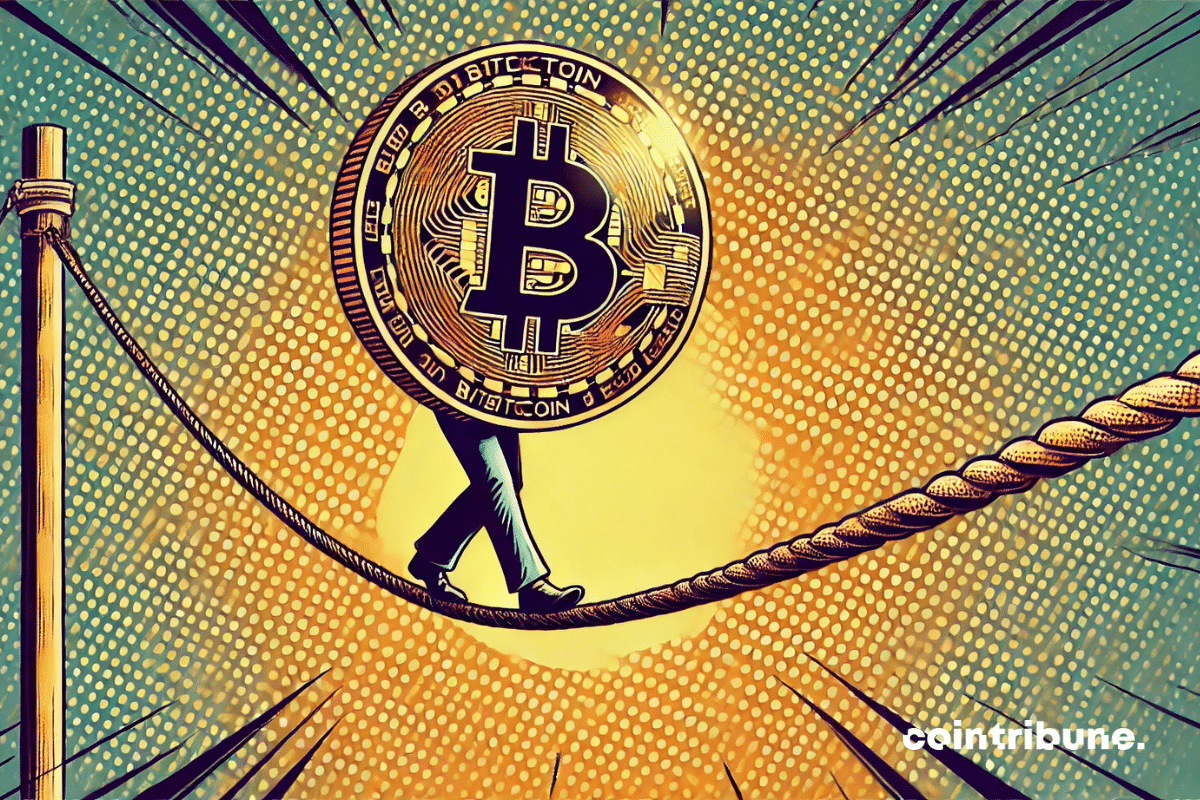The Bitcoin market has just experienced a brutal correction. In the span of 48 hours, a massive wave of capitulation has resulted in more than $2.16 billion in realized losses for investors. Behind this drop lies a well-known pattern for analysts: weak hands, often the most recent entrants, have liquidated their positions at a loss. Far from being trivial, this wave of hasty selling raises questions about market strength and investor psychology in the face of sudden corrections.
Home » Archives for Luc Jose Adjinacou » Page 12
Luc Jose A.
Diplômé de Sciences Po Toulouse et titulaire d'une certification consultant blockchain délivrée par Alyra, j'ai rejoint l'aventure Cointribune en 2019. Convaincu du potentiel de la blockchain pour transformer de nombreux secteurs de l'économie, j'ai pris l'engagement de sensibiliser et d'informer le grand public sur cet écosystème en constante évolution. Mon objectif est de permettre à chacun de mieux comprendre la blockchain et de saisir les opportunités qu'elle offre. Je m'efforce chaque jour de fournir une analyse objective de l'actualité, de décrypter les tendances du marché, de relayer les dernières innovations technologiques et de mettre en perspective les enjeux économiques et sociétaux de cette révolution en marche.
Bitcoin's volatility is once again at the heart of discussions. While the cryptocurrency briefly fell below $79,000, Standard Chartered Bank believes that the correction could intensify, bringing BTC into a range between $69,000 and $76,500 by Monday. This projection is based on several market indicators, including the selling pressure from massive Bitcoin ETF outflows and the increase in short positions by hedge funds. Should this decline be viewed as a simple correction or a signal of a deeper reversal?
The crypto market is buzzing. After a week marked by a sharp correction and intense selling pressure, bitcoin surged to $85,120, rekindling hope among investors and traders. However, this sudden rise is based on complex dynamics that raise questions about its sustainability. While some see it as a buying opportunity, others warn of a possible relapse if the trend does not hold. Thus, the clash between these two perspectives creates a palpable tension in the market.
The crypto market is often the stage for spectacular movements, where euphoria can propel an asset to dizzying heights before a brutal reversal sweeps everything away. Indeed, the Pi Network (PI) embodies this phenomenon today in all its excess, with a surge of 35% in its price on February 26, 2025, and a trading volume that exceeds $2.3 billion, with a market capitalization approaching $16 billion. While some investors see this as a sign of a bullish rally still in the acceleration phase, others fear an imminent correction, reinforced by contradictory technical indicators. Is this resurgence of interest in PI the beginning of a lasting ascent or simply a flash in the pan doomed to extinguish quickly?
Economic tensions between the United States and the European Union have reached a new high. Donald Trump, true to his protectionist policy, has just announced a dramatic increase in customs duties on European exports, raising their level to 25%. A brutal decision that far exceeds the 10% mentioned during his campaign and places Europe in a situation of diplomatic and economic urgency. The major powers of the Old Continent must now face a threat that could reshape global trade balances.
The crypto market is going through a turbulent phase. Indeed, Ethereum (ETH), the second-largest cryptocurrency by market capitalization, has experienced a sharp decline of 20% in just three days, bringing its price to around $2,100. Such a sudden correction raises questions: is it merely a moment of volatility or a warning sign for investors? Between unfavorable macroeconomic factors and signs of resilience in the derivatives market, the future of ETH hangs in a fragile balance.
Bitcoin is going through an unstable period. Between spectacular rallies and dizzying falls, the queen of crypto shapes the mindset of investors with rare brutality. In recent days, the market has experienced an intense sequence marked by massive sell-offs on spot Bitcoin ETFs and growing pressure on futures contracts. This phenomenon is anything but trivial. It illustrates a lasting climate of doubt, where the extreme volatility of BTC drives some to give up while others seek opportunities.
In a sector where every legal battle shapes the future of the market, Coinbase has just scored a decisive point. The exchange announced on LinkedIn this Thursday, February 27, 2025, that the legal proceedings against it had been dropped, a statement that resonates like a victory for the company, but…
As the war in Ukraine enters a new phase of uncertainty, a major agreement between Washington and Kiev is reshaping the contours of Western support. Volodymyr Zelensky is set to travel to the United States this Friday, February 28, 2025, following the adoption of a pact that allows for American access to Ukrainian rare earths and establishes a reconstruction fund for the country. This compromise, which intertwines economic stakes and military considerations, marks a critical step in the relationship between the two nations. The discussions, conducted under tension, ultimately led to an agreement that could play a decisive role in the geopolitical future of the region.
The crypto scene has just experienced a new episode of turbulence: Bitcoin has dropped to $83,400, its lowest level since November 2024. This sudden correction triggered over a billion dollars in liquidations in the derivatives market. Such a situation has shaken investor confidence. Behind this decline, a convergence of macroeconomic and financial factors weighed on the asset, at a time when the strength of Bitcoin ETFs and the influence of Strategy on the market are being called into question.
The new real estate market has entered an unprecedented slowdown spiral. While access to homeownership remains a priority for many households, the production of new housing is at its lowest level in over 50 years. In 2024, only 59,000 new homes were put up for sale, a decrease of 50% compared to 2022. Thus, this crisis, much deeper than a simple cyclical slowdown, is the result of a combination of structural and economic factors. Rising construction costs, increasingly difficult financing, and the withdrawal of institutional investors are all elements that hinder a rapid recovery.
The foreign policy of the United States could undergo a major shift. As diplomatic tensions between Washington and Moscow have intensified in recent years, Donald Trump appears ready to rewrite the rules of the game. The American president, a favorite in the race for the White House, is considering an economic rapprochement with Vladimir Putin's Russia, aiming to break with the sanctions strategy imposed under Joe Biden. Is this a maneuver intended to undermine the BRICS alliance?
Bitcoin wobbles below a critical threshold, and the pressure is intensifying. While the cryptocurrency had exceeded the $90,000 mark a few weeks ago, it now finds itself below $85,000, prompting analysts to consider a more pessimistic scenario. Between massive ETF sell-offs, cascading liquidations, and macroeconomic uncertainties, volatility is resurfacing, reigniting fears of a collapse to $81,000. Is the market on the verge of a harsh reversal, or is this just a temporary correction?
The next bull cycle will be unlike any other. Indeed, the era when all cryptocurrencies surged seems to be over. Ki Young Ju, CEO of CryptoQuant, sounds the alarm: in the year 2025, the majority of altcoins could disappear. Only those capable of proving their economic viability and capturing the attention of institutional investors might survive. This prediction comes as 24% of the 200 largest cryptos have reached their lowest levels of the year. Is the market sorting through solid projects and the others? The prospects for crypto ETFs, the fundamentals of altcoins, and investment trends now seem to be the true arbiters of survival in this ultra-competitive sector.
The world of crypto is based on constantly evolving market dynamics, where the perception of risk and return shapes investors' decisions. While Bitcoin struggles to maintain its support levels, a key technical indicator on Ethereum rekindles traders' enthusiasm. According to analyst Doctor Profit, ETH shows an exceptional risk-reward ratio, reinforcing expectations of a massive rise in the coming months. Between technical analysis and investor accumulation, the asset may well find itself at a strategic turning point.














